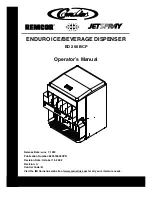
JPK 3
7
Installation
4.1.4 Mounting of the Built-in rotary
flange
The mounting is effected by means of the in-
tegrated built-in rotary flange and the here-
with supplied screw connections [swivel nut,
grommet and flat seal]. The built-in rotary
flange serves as an element connecting to
the cold water system.
The built-in rotary flange has to be
mounted in flow direction. This one is
marked by a cast in arrow under the cas-
ing (see fig.1)
.
ATTENTION
(see chapter “Security Advices and Dan-
gers in Case of Non-compliance”)
The flange surface of the built-in rotary
flange has to be positioned horizontally.
The built-in rotary flange has to be mounted
so that any mechanic tensions will occur.
Unless a mechanic damage right up to the
break of the pipe line or the built-in rotary
flange can be caused. Considerable water
damages can be the consequential effect.
Persons that stay near to the sample water
cooler are exposed, in that case, to a sani-
tary risk, due to hot water.
At installation, it has therefore to be paid at-
tention to the fact that any strong forces act
upon the pipe line, the built-in rotary flange
and the sample water cooler.
4.1.5 Connection to the Heating
Circuit
The connection to the heating circuit is ef-
fectuated by means of a ball cock with BSP
G ¼” female thread. For the mounting / dis-
assembly of the sample water cooler and for
the cleaning of the sieve a shut-off possibil-
ity should be inserted before the sample wa-
ter ball cock.
On mounting it has to be observed, that the
retention sieve with the sieve cloth pointing
upward is located on the entry side of the
sample water ball cock.
Fig. 2:
Connection to the Heating Circuit
sample water
ball cock
retention sieve
clamp-ring
screw connec-
tion ¼" x ø6mm


































